ASUS PB278Q Review: An IPS Competitor Emerges
by Chris Heinonen on November 19, 2012 11:00 PM ESTASUS PB278Q Color Quality
The PB278Q ships with an sRGB preset in the display, but unlike the ProArt line this doesn’t come with a guarantee of a DeltaE < 5 for color quality. Since the ProArt DeltaE didn’t meet that standard in my testing (and I don’t have enough details to know what color points they are even testing to get that number), this was a fine change by me. Compared to all the other preset modes, sRGB was by far the most accurate, so I used it for our uncalibrated, 200 nits profile testing.
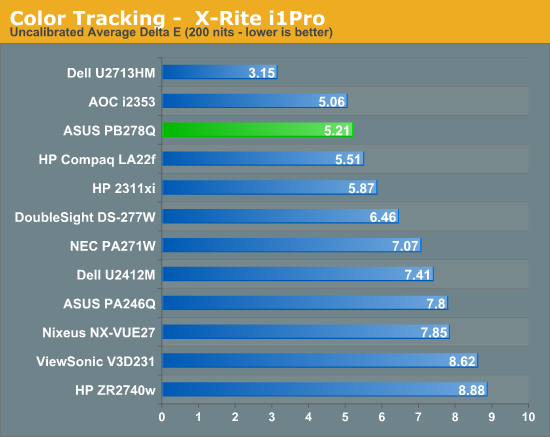
Our average uncalibrated dE is 5.21, which is actually very good for a 27” display right out of the box. You will notice that some 27” displays that were tested prior to my taking over display testing, like the Dell U2711, are not here in the graphs. This is intentional as those were tested with a different combination of hardware that can produce results that look better than they actually are. All of the displays in this chart now are measured using an i1Pro for every measurement except for black level, which an i1DisplayPro is used because of its more accurate low light readings.
Moving past that, the sRGB mode isn’t incredibly accurate in comparison to the recently reviewed Dell U2713HM display, but it is better than every other 27” display I have put onto the bench.
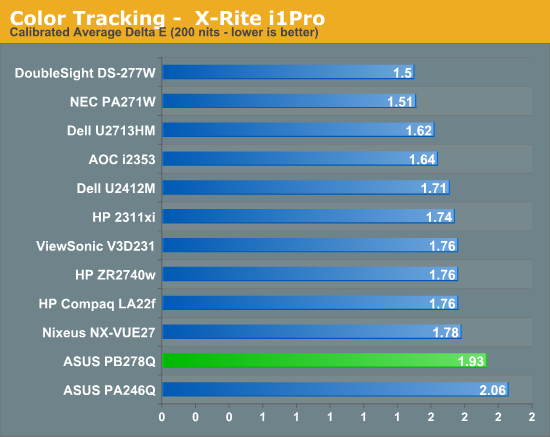
After calibration the PB278Q improved but not as much as some of the other displays have. What is really throwing this off is one shade of blue that has a dE over 6, which pulls that average up. Looking at the median error we still see a worse result than the other 27” displays out there and a grayscale that has a higher dE across the board than the other displays. This is getting picky, since all of these dE values mean that you probably won’t see any difference between the displays, even side by side, but it still doesn’t perform quite as well after calibration.
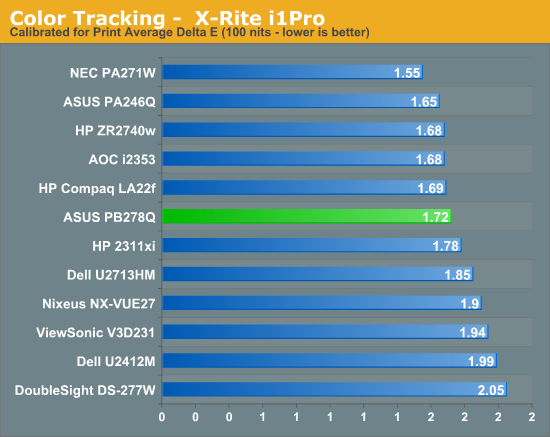
With the brightness range of the PB278Q it was easy to get the ASUS down to 100 nits for our print calibration testing without having to manipulate the LUT to do so. Here we see a bit of an improvement over the 200 nits numbers, and we manage to do better than the other 27” displays we have tested. The NEC is still the leader for low light image quality, but the ASUS is right behind it and would do a good job for those that need to do print work at lower light levels.
The color gamut on the PB278Q is going to be limited to sRGB due to the use of an LED backlighting system that uses while LEDs, and we see it has 79% of the AdobeRGB gamut available. There's nothing at all surprising or different about this; it's exactly what we expected to see.

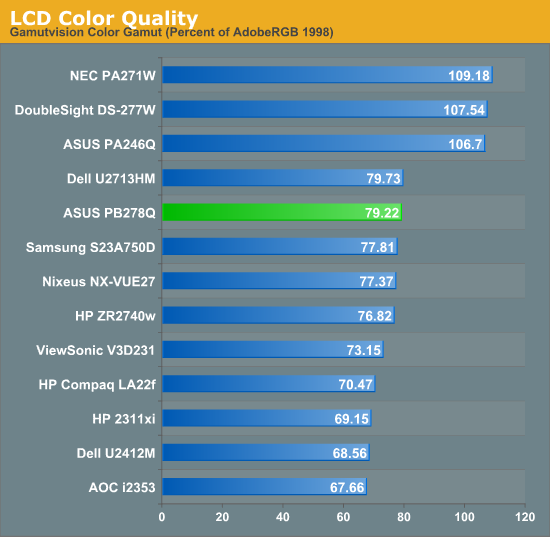
Overall the PB278Q does a pretty good job on the color quality testing. The default sRGB mode is better than most and will be good enough for those that want to have more accurate colors but aren’t willing to pay a premium for the hardware to do a full calibration. The 200 nits calibrated numbers are a little worse than I had hoped, but they are so close to others you likely won’t be able to tell at all, and the 100 nits numbers are very good.


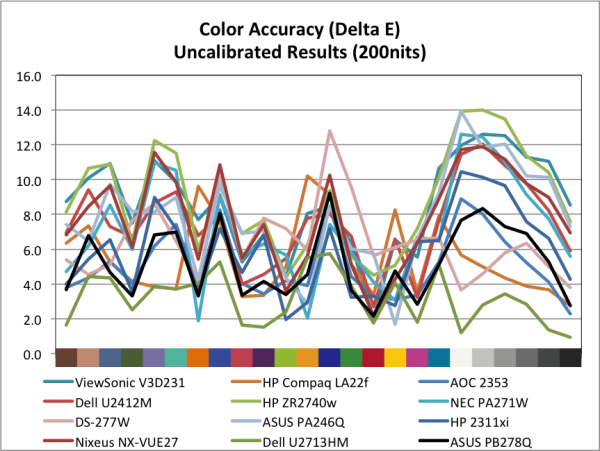
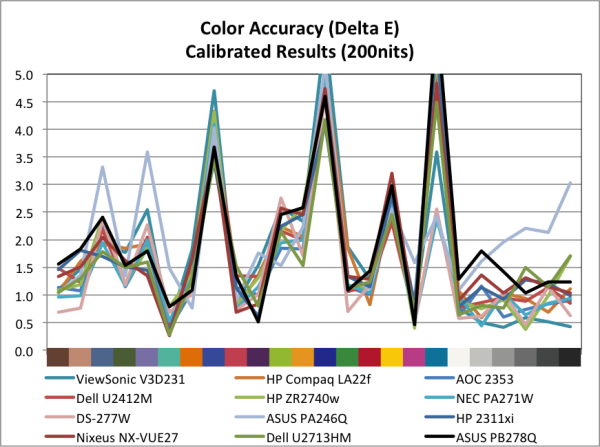
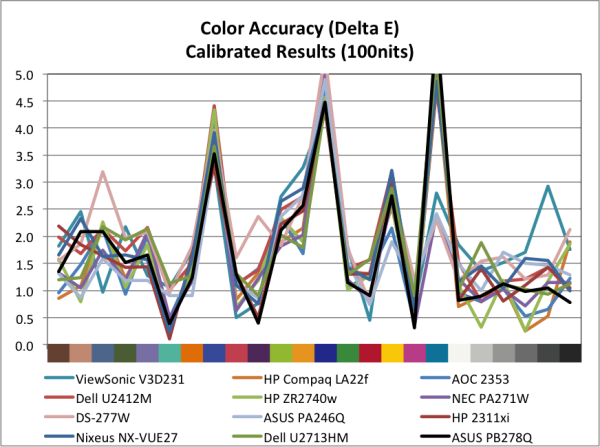








55 Comments
View All Comments
Old_Fogie_Late_Bloomer - Wednesday, November 21, 2012 - link
I don't really mind the 16:9 aspect ratio so much anymore; it's the 1080 lines of resolution that get me. I have a 1600x1200 monitor and a 1920x1080 monitor at work...the former is my primary monitor, 'cause those 120 pixels matter when coding or looking at spreadsheets. I'd swap the 1080p monitor for another UXGA one if I could (but I was lucky to office-scavenge the one I have :-P ).If manufacturers wanna go 4K at a reasonable price, that's fine. Otherwise, I guess my next monitor purchase will probably be a U2711 (or another U2410).
devilmon - Tuesday, November 20, 2012 - link
I think you forget to test about Responsiveness of pixel on this monitor. I think overdrive / response time compensation (RTC) technology is the best feature that cannot found in other high-end monitor.PS. I'm quite surprise why your test result is far from another review. Do you use defect monitor?
http://www.tftcentral.co.uk/reviews/asus_pb278q.ht...
Ryan Smith - Tuesday, November 20, 2012 - link
We don't have pixel response time tests with different TraceFree settings, but we do have tests at the stock setting of 60.http://images.anandtech.com/doci/6460/Input%20Lag....
11ms pixel response time + 17ms input lag
cheinonen - Tuesday, November 20, 2012 - link
TraceFree doesn't affect the lag time at all in my testing. I ran SMTT at all the various TraceFree settings and that doesn't change the lag at all. It does change the ghosting of the LCD which I did comment on, but it didn't change the lag in my testing.Krysto - Tuesday, November 20, 2012 - link
Nexus 10 has a PLS screen, too. And it's actually slightly higher resolution than this.dingetje - Tuesday, November 20, 2012 - link
thx for the reviewif have a question:
will the EVGA Z77 Stinger Mini-ITX Motherboard be in the upcoming mini itx round-up article?
fragemall - Tuesday, November 20, 2012 - link
I think its time to move on from using excel to generate those surface plots. Virtually any software (including Matlab) can be used to make a better figure.cheinonen - Tuesday, November 20, 2012 - link
I'm aware of this and have been working on making the charts better, I just haven't decided on something yet but will try to figure it out soon.Crazyeyeskillah - Tuesday, November 20, 2012 - link
It's too bad the lag is so high, that is incredibly noticeable and you will feel it in every fps game you play, there is no covering it up, this is not a gaming monitor but a graphics/editing monitor, don't waste your money if you are a gamer. Scaler=FailerSubyman - Tuesday, November 20, 2012 - link
I recently purchased a Viewsonic VP2770 that uses a PLS panel. I'm enjoying it more than the IPS panels I've had in the past. It has all the features that I was looking for such as non-PWM backlight, USB 3.0 hub, 27", 1440p, good selection of inputs, and a good stand. Too bad more places do not review it.